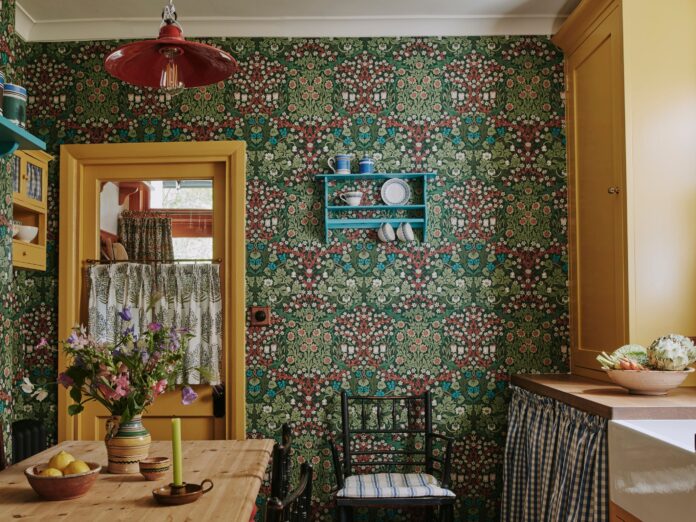William Morris created designs more than a century ago, yet they feel surprisingly alive in modern interiors. His work captured the beauty of vines, flowers, and birds in detailed patterns that never look dated.
Today, homeowners are once again filling their rooms with Morris wallpapers, fabrics, and accessories.
The reasons are clear: the patterns add depth, warmth, and a sense of craft that people often miss in fast furniture and plain white walls.
Why Morris Patterns Feel Relevant Again
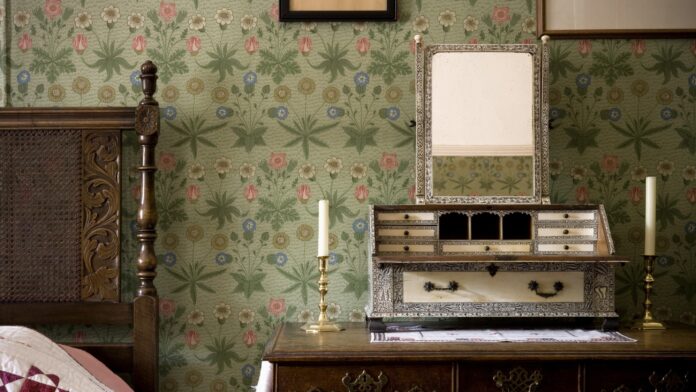
There is something comforting about motifs inspired by leaves and blossoms. They connect the indoors with nature, which many of us crave when life feels busy. Morris designs also carry an old-world charm that balances well with sleek, modern furniture. Instead of looking fussy, they provide texture and rhythm.
When I look at a Morris wallpaper, I notice how it transforms the mood of a room instantly. The lines feel hand-drawn, the colors have weight, and the composition holds the eye. That is a rare quality in today’s mass-produced décor.
A few qualities explain why Morris fits so well in current homes:
- Nature in focus: Branches, flowers, and birds soften hard corners and connect us with the outdoors.
- Color depth: Rich shades cut through the sterility of minimalist interiors and give rooms personality.
- History as value: Choosing Morris patterns brings an element of heritage into daily life.
The mix of natural beauty and cultural significance explains why so many decorators return to him as a source of inspiration.
Everyday Details That Introduce the Pattern Gently
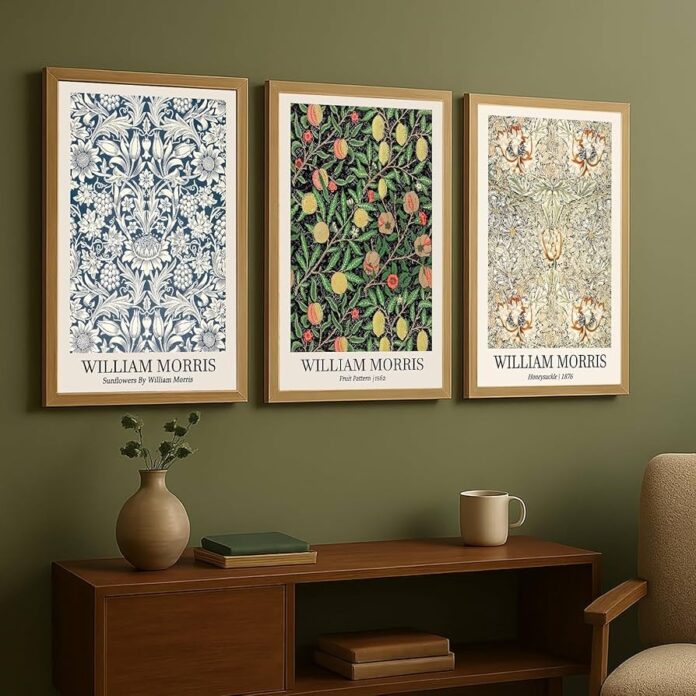
Not every space can handle a full wall of Acanthus or Strawberry Thief. In smaller homes or minimalist apartments, it often works better to start with a few accents. Even one item can spark a whole design conversation.
One of the most practical entry points is through serving ware and household accessories. I love how patterned trays carry Morris designs in a subtle way.
A serving tray with a heritage motif on a modern coffee table feels like a perfect bridge between past and present.
Guests notice it, it gets used daily, yet it never dominates the space. Small touches like that help you live with the design before deciding to take it further.
Wallpapers That Set the Tone in a Room
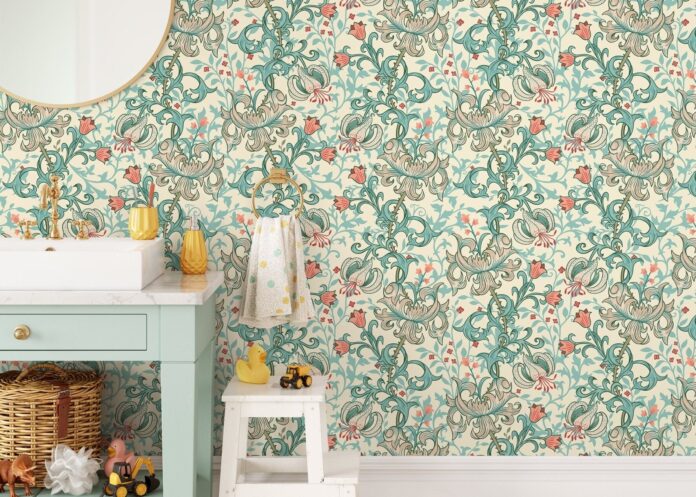
When you want drama and character, wallpaper is the strongest tool. Morris patterns have a way of creating intimacy in a room. They don’t just sit on the wall; they tell a story with every curve of a vine or outline of a flower.
Decorators often recommend them in spaces that need identity:
- Dining rooms where guests gather and conversation flows. A patterned wall behind a dining table feels warm and anchored.
- Entryways where the first impression matters. Even a small hallway feels more welcoming with a bold motif.
- Bedrooms that call for coziness. Soft florals around a headboard wrap the space in comfort.
Wallpaper works best when paired with clean furniture lines. That contrast highlights the artwork on the wall while keeping the room practical.
Fabrics That Add Softness and Depth
Textiles are another avenue for Morris designs. A single chair upholstered in a heritage fabric can turn into the star of the living room. Curtains patterned with vines can draw the eye upward, adding height and drama. Even a cushion on a neutral sofa makes a difference.
The trick is balance. Too much pattern overwhelms. Pair a Morris fabric with plain upholstery, solid rugs, and simple wood tones. The result is a room that feels alive yet controlled. When chosen carefully, fabric becomes a canvas that grounds the rest of the décor.
Color Palettes That Keep the Patterns Fresh
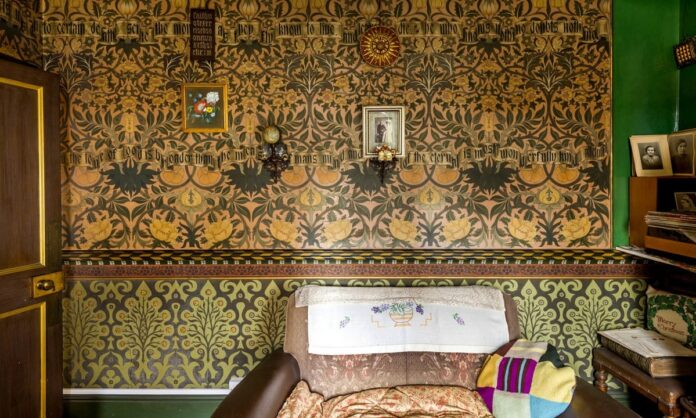
Victorian homes loved heavy greens, deep reds, and indigo blues. Today, decorators often reinterpret the same motifs in lighter shades. I’ve seen Strawberry Thief in pale sage, creams, and soft blues – perfect for sunlit apartments where darker tones might feel heavy.
Color variation keeps Morris adaptable. A darker version feels right in a cozy study with a fireplace. A lighter reprint shines in an open-plan kitchen where natural light floods in. Homeowners can choose based on mood rather than tradition.
Mixing Old Craft With Modern Design
The key to success lies in blending. Morris designs work not by turning a room into a Victorian museum but by letting one piece carry the history while everything else remains streamlined.
For example: a patterned armchair in front of a white wall creates a focal point without clutter. A Morris wallpaper in a dining nook can live beside a modern chandelier and still feel harmonious. The contrast creates energy and makes the room feel curated.
Some guiding ideas that always help:
- Anchor one element (wallpaper or upholstery) and keep other items neutral.
- Let wood tones echo the natural inspiration in the pattern.
- Use glass or metal lighting fixtures to avoid heaviness.
This balance allows Morris designs to feel intentional rather than overwhelming.
Sustainable Values That Speak to Today’s Buyer
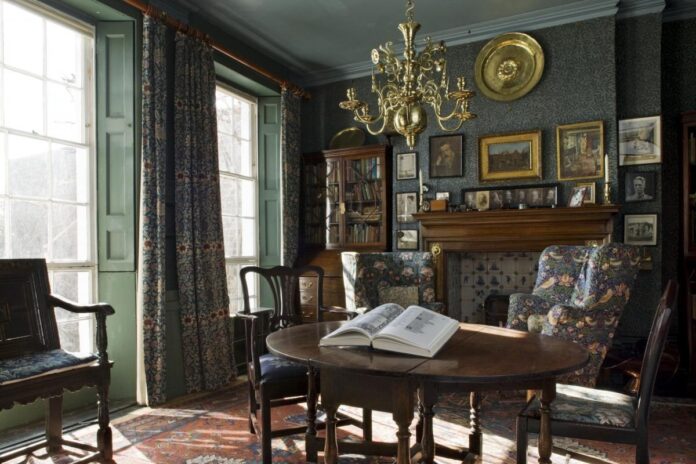
William Morris believed in craftsmanship, quality, and respect for materials. That philosophy resonates with today’s slow-living approach. People want interiors that last longer than one season. Many Morris textiles are still made with natural fibers and traditional weaving, which means they age well and support artisanal work.
Choosing such designs is not just about beauty. It signals a commitment to sustainable values. In a world of disposable décor, Morris patterns stand as a reminder that home pieces can endure. That makes them a smart choice for anyone who wants substance with style.
Practical Ways to Experiment Without Overcommitment
You don’t have to cover a wall or upholster a sofa to bring Morris into your home. There are many smaller, playful ways to test the waters:
- Framed wallpaper samples act as affordable artwork.
- A lampshade wrapped in a heritage motif introduces pattern gently.
- Table linens with vines or florals dress up a plain dining set.
- A set of cushions creates seasonal variation without major changes.
I often suggest starting with just one or two accents. That gives you space to see how the pattern interacts with light and furniture before expanding further.
Closing Thoughts
The renewed love for William Morris patterns reflects a deeper shift in home decor. People no longer want lifeless, temporary interiors. They want design with history, with warmth, and with meaning. Morris provides all three.
His motifs of vines, flowers, and birds slip seamlessly into homes that mix old and new. They work in wallpapers, fabrics, trays, and small accents, adapting to many styles and budgets. More than decoration, they represent a return to authenticity and craft.
That is why Morris is not just a trend. His patterns are part of a larger revival of heritage design in modern life, and they are likely to stay relevant for years to come.

